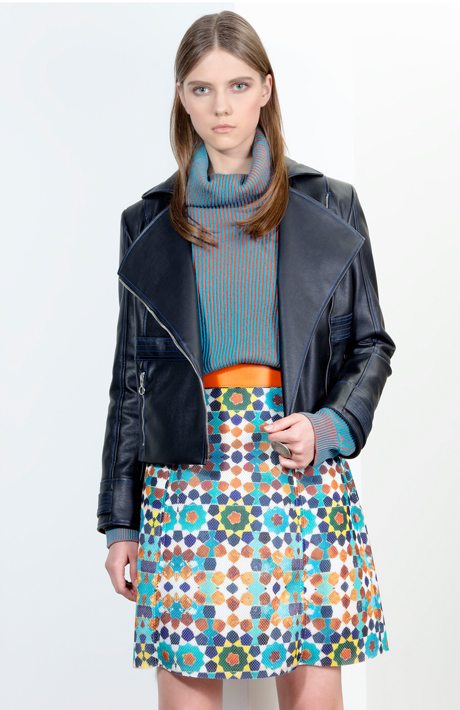Miahatami FW 2015
È un piacere per noi presentarvi l’interessante lavoro della designer iraniana Narguess Hatami.
Dopo aver iniziato il suo percorso nel settore da Paola Frani, si perfeziona e cresce professionalmente nelle esperienze affiancando Massimo Giorgetti per MSGM.
Da questo inverno Narguess ha lanciato la sua prima linea donna, ispirandosi alla cultura persiana dalla quale proviene da cui trae forme e ispirazioni. Per “leggere” la collezione, occorre dunque aver presente almeno alcuni, fondamentali elementi dell’arte decorativa persiana e degli archetipi architettonici di una civiltà millenaria.
In primo luogo le lavorazioni aynekari, utilizzate per creare specchi a rilievo che adornano gli interni, ma anche i mosaici di maiolica, geometrici e coloratissimi, ed infine le straordinarie finestre completamente colorate e disegnate degli andarouni, gli ambienti più intimi delle abitazioni tradizionali riservati alle donne.
The first collection signed by Narguess Hatami reveals the “signs” of an unmistakable and total Western contemporaneity: in the design logics which define it, in the cuts and shapes of the looks, in the material processings which start from sophisticated textures often expressing hi-tech declinations, well-balanced in every single part of the collection.
Without any doubt its soul can be defined as fully actual chic. The designer – while avoiding the minimal concession to ethnic thanks to a really careful, neat and original interpretation process – shows a true and deep love for the extraordinary culture of her homeland, Persia.
The insipiration source is offered in a particular way by architectures, décor, colors, geometrical elements as well as by the enchanting splendor of certain historical buildings. All that lives and vibrates in the sixties collection looks with its complementary accessories.
In order to “feel” the collection it is necessary to be aware at least of some basic elements belonging to the decorative arts and architectural archetypes of a millenary civilization, starting from the aynekari processing, used to create mirror in relief adorning the interiors, the geometrical and colorful tiled mosaics, the extraordinary decorated and polychromatic windows of the andarouni, the most intimate rooms in the traditional houses reserved for women.
Conscious forms. A look to the Seventies is evident, for instance in the wide trousers as in miniskirts. There is a desire to ease, in the soft volumes of dresses and sweaters which move away from the body. Blouses show a “bon ton” intention. But there is also a rational process construction of the items, which leads to create ripples at the top – both frontally and on the back – of jackets, shirts and coats, keeping them away from the silhouette, balancing geometry and harmony.
In the formal definition of the entire look details play a leading role: a band can become a belt, or simply can fix the item to the body.When it is thin, it creates a bow to be slipped and slipped off, playing with the blouse collar.
– Material interpretation.
The focus is in any case on materials with a proper high value. always applying the elaboration techniques in order to obtain something different from the starting point.
Wool cloth, for instance, is coupled and needle punched. The architectural and formal strength of the materials tends generally to be preserved and reproduced in the item structure. The importance of the volumes is always significant: the aynekari motifs are recreated by using whole sequin sheets, which are then cut, folded and applied on the items, to obtain the desired reliefs.
Regarding skin or fur, eco-friendly versions are winning without hesitation. And the effect of preciousness is often given by handmade embroideries.
Techno wonder. The pleasure of experimentation leads to contrast plays by mixing noble materials with futuristic elements. In the more elegant and precious looks the lightest silk organza is combined with a reflective texture, always with the intention to decorate the item with patterns from the Persian tradition. Other techno materials are mixed with jersey, inventing day looks with an aim of elegance.
– Vibrant colors.
To suggest brightness, warmth and élan even in winter, the bright colors of the majolicas are winning: bottle green, flame red, orange, intense blue, all kaleidoscopic shades brought back to “order” by some white and some black.
The must have. The combination of shirt and trousers printed in the tile colors shines and fascinates like the interior walls of a sumptuous building. The perfect balance between contemporary West and millenary Persia vibrates in the three-dimensional looks with applied embroideries that recall the aynekari works, if they were enchanted mirrors which stand out on items, showing totally actual forms and tailoring.





No Comment